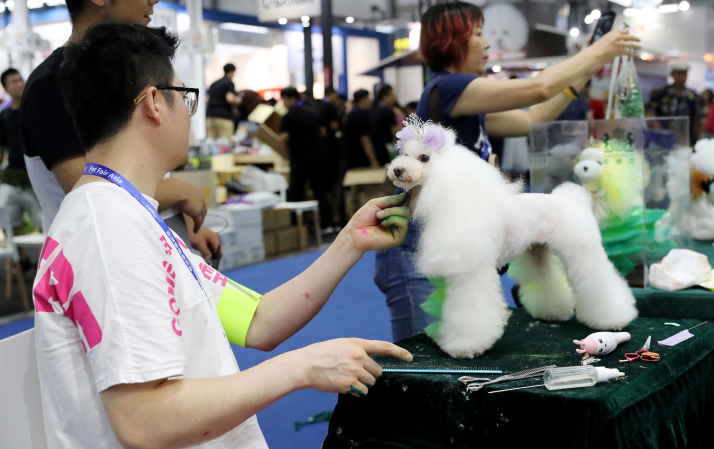| Opinion |
| China's Pet Economy Booms as Owners Go High-End | |
|
|
 A poodle is groomed during the 21st Pet Fair Asia in Shanghai on August 25. The event was held from August 22 to 26, with more than 1,300 companies bringing 16,000 brands of pet supplies (XINHUA)
At an international pet fair held recently in Shanghai, local cat owner Xiao Wanqing packed a 28-inch suitcase full of imported cat food and toys and ordered a courier to deliver it to her home. The 21st Pet Fair Asia, which received more than 140,000 visitors over the weekend, closed on August 26. Many pet-lovers like Xiao attended, bringing large suitcases to fill with global pet products. Xiao trusts the quality of imported cat food, as "big foreign pet food suppliers are more established and have a good reputation," she said. More than 1,300 exhibitors set up booths in the 140,000-square-meter exhibition hall. "My dog has a weak stomach, which food do you recommend?" asked Zhang Ran, a middle-aged Shanghai resident, at Royal Canin's booth. Based on the professional advice offered by Li Xi, the company's vet, Zhang immediately ordered 6 kg of digestive dog food for her beloved Bichon Frise. Zhang said that when she got her dog eight years ago, she only knew of two different types of dog food, one for puppies and one for adult dogs. But now, there are more and more choices on the market, and she has to learn about the different types of food designed for different breeds. "China's pet food market has seen an increase in products in recent years to cope with the rising demands of middle-class pet owners," said Li. The company he works for has produced more than a dozen prescription dog foods for the Chinese market, aiming to help dogs with illnesses like liver or intestinal problems. As Chinese people pursue a healthier and happier life, they are willing to lavish more on their furry friends. Domestic pet food producers are catching up with this trend, according to Zhao Haiming, General Manager of Pure & Natural, a Chinese pet food brand. "Our market research found that pet owners in China are increasingly better-informed regarding the health of their pets and closely check the ingredients and nutritional information before buying pet food," said Zhao. "We are developing new products to catch up with consumer needs." According to the Pet Industry White Paper 2018 published by Goumin.com, a Chinese online pet forum, China's cat and dog owners are expected to spend over 5,000 yuan ($740) per pet in 2018, an increase of 15 percent from last year. Overall, the value of China's cat and dog market has surpassed 170 billion yuan ($24.88 billion). Xiao said that in addition to cat food, raising a pet includes other expenses like grooming, vaccinations and medical treatment. In total, the cost of looking after her cat amounts to 10,000 yuan ($1,463) per year. American company Litter Robot brought an auto-cleaning litter box to the fair, which allows litter boxes to be cleaned just once every few weeks. According to the company's salesmen, more than 200 units are sold via Chinese e-commerce platforms every month, each costing over 5,000 yuan. The World Cat Show recognized by the Cat Fanciers' Association (CFA), a global organization for preserving pedigree cats, also took place during the fair. Qian Zheng, director of the cat zone of the Pet Fair Asia, said that over 200 pure bred cats attended the show. Qian is also a professional breeder of Persian cats. She said that nowadays it is quite easy to contact professional breeders for consultation via social media, but 10 years ago, there were few such options. Qian bought her first Persian cat from a foreign breeder via e-mail. "At that time, no foreign breeders were willing to sell pure bred kittens to Chinese buyers. They didn't believe that we would treat the cats with the right attitude and care, and rumors about the Chinese eating cats certainly didn't help." Qian said that she tried hard to convince the breeder that there was no way she would spend thousands of dollars on a cat and not treat it as best she could. Now, as one of the most well-known cat breeders in the industry, Qian's Persian cats have won first place in the Persian-bred category at the CFA cat show for two consecutive years. "Few Chinese pet owners attended the CFA cat show years ago. But now, new faces and new kittens from China appear every year," she said. Qian currently owns 20 to 30 Persian cats, and these fluffy companions cost her between 600,000 ($87,811) and 700,000 yuan ($102,447) every year. According to research by the China Agricultural University, the pet industry develops rapidly when a country's GDP per capita is about $3,000 to $5,000. China's per-capita GDP was around $8,800 last year. As Asia's largest trade show for animal supplies and aquariums, Pet Fair Asia started in Hong Kong before moving to Shanghai in 1999, a decision spurred by the growing demands of the Chinese mainland market. Since then, the scale of the fair has grown exponentially, from a 15,000-square-meter space in Shanghai Mart in 2003 to a whopping 140,000 square meters in the Shanghai New International Expo Center this year. This is an edited excerpt of an article originally published by Xinhua News Agency Copyedited by Laurence Coulton Comments to zhouxiaoyan@bjreview.com |
|
||||||||||||||||||||||||||||
|